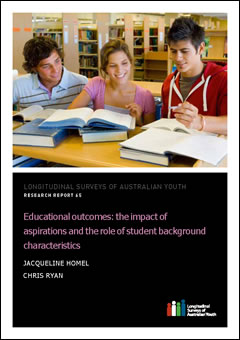Description
The authors examine the relationships between student background characteristics, educational aspirations and educational outcomes using data from the Longitudinal Surveys of Australian Youth (LSAY). The methodology involved econometric analyses to determine whether student background factors influence Year 12 completion and university participation only via their indirect impact on aspirations. The results confirm the findings from previous studies: that aspirations have a large impact on educational outcomes. In general, aspirations have a similar impact on outcomes for those from disadvantaged backgrounds compared with those not from disadvantaged backgrounds.
A recording of the webinar Aiming high: what drives the educational and occupational aspirations of young Australians? held on 5 June 2014 is available for viewing from our Webinar series page.
Summary
About the research
Current educational reforms and targets, such as increasing higher-level qualifications amongst the working-age population, are reliant on improving the educational outcomes of people from disadvantaged backgrounds. This paper follows on from previous research, which has shown that educational aspirations are strong predictors of educational outcomes, including Year 12 and tertiary participation. The focus of the paper is to understand the relationships between student background characteristics, educational aspirations and educational outcomes.
The researchers set out to determine whether student background factors, such as socioeconomic status (SES) and Indigenous status, only affect educational outcomes via their indirect effect on educational aspirations. They also examine whether aspirations have the same effect on educational outcomes for young people from disadvantaged backgrounds as those who are not from disadvantaged backgrounds. The analysis is based on data from the Longitudinal Surveys of Australian Youth (LSAY), which collects information on aspirations at age 15 years via questions on intentions to complete Year 12 and post-school study plans.
Key messages
- Educational aspirations have a substantial effect on educational outcomes.
- Individuals who plan to complete Year 12 are 20—25% more likely to do so, compared with those who do not intend to complete Year 12.
- Individuals who intend to go onto university are 15—20% more likely to do so, compared with those who do not have post-school university plans.
- Interactions between educational aspirations and student background characteristics do not seem particularly important, suggesting that aspirations have a similar impact on educational outcomes, regardless of socioeconomic status and Indigenous status.
- There were some significant interactions between aspirations and academic performance. For example, those who considered their academic performance to be average or below average, relative to their peers, were less likely to achieve their aspirations compared with those who considered their performance to be above average.
The authors conclude that interventions to lift the aspirations of young people should have a similar impact for all young people, including those most at risk of poor educational outcomes.
Rod Camm
Managing Director, NCVER
Executive summary
The paper studies the relationship between educational aspirations and their realisation. The results presented here confirm those of other studies: that aspirations have a substantial effect on educational outcomes.
However, it also appears that the method of analysis matters. Once we take into account the possibility that the unobserved components of aspirations and their realisation may be correlated, the real effect of aspirations on outcomes appears to be around one-half of that measured by approaches that ignore any such correlation. The correlation between aspirations and realisations may arise because factors such as motivation, perseverance, ambition, ability or beliefs about the value of education may affect both phenomena.
The data studied here are from the Y03 and Y06 cohorts of the Longitudinal Surveys of Australian Youth (LSAY). We use information on the educational aspirations of individuals when they were aged 15 years and compare them with their later educational outcomes. The results are consistent with an effect typically reflecting the aspirations of a 15-year-old on the probability of Year 12 completion being in the range of 20 to 25 percentage points, and of the effect of intending to study at university on actually doing so of the order of 15 to 20 percentage points. These are large effects, much larger than the effects of school achievement or family background on these outcomes.
In general, these aspirations tend to have a similar impact on outcomes across individuals, regardless of their demographic background. That is, interaction effects between aspirations and the demographic characteristics do not seem particularly important.
There are, however, significant interactions between aspirations and real and relative academic performance, which suggests that high-achieving individuals are more likely to realise their aspirations. Furthermore, those who considered their performance to be average or below average were less likely to realise their aspirations than those who considered their performance to be well above average.
This study does not focus explicitly on how aspirations are determined or how effective alternative policies might be in changing the aspirations of individuals. Essentially, however, the results of this study push the emphasis back onto the processes that shape the aspirations of young people, since it found that these do determine young people’s (educational) futures and translate into outcomes in a similar way across individuals, regardless of their social background.
The results suggest that if it is possible through policy or the programs of schools or community organisations to change the aspirations of individuals, such changes in aspirations should translate uniformly across all individuals into increased educational outcomes. Interventions, for example, that increase the educational aspirations of Indigenous youth and young people from low socioeconomic status (SES) backgrounds might have the same impact on their outcomes as those changing the aspirations of people from other parts of the social welfare distribution.
Download
Related items
Aspirations have a substantial effect on educational outcomes as they influence whether students wil… Show more
